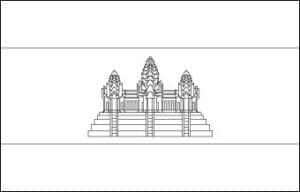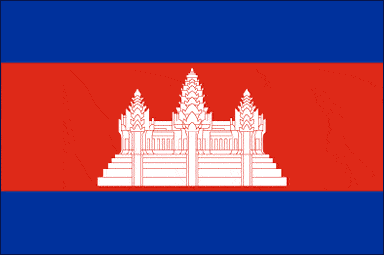
In 1993, the flag was formally accepted. It was initially put into effect on October 29, 1948, and it stayed in use until October 1970.
The Cambodian flag reappeared in 1993 with the restoration of the country’s monarchy.
The national flag of Cambodia proudly displays the Hindu temple Angkor Vat, which is an essential and noteworthy component of the country’s rich past. The nation’s royalty is represented by the color blue. The red stands for the country, and the white for the faith. The universe’s framework is represented by the temple’s symbol.
Facts about Cambodia flag |
| Country | Cambodia |
|---|---|
| Adopted | 1993 (previously used 1948–1970) |
| Revision | 1863, 1945,1948, 1970, 1975, 1979, 1989, 1991, 1992, 1993 |
| Design and Colors | Three horizontal bands of blue, red (double width) and blue, with a depiction of Angkor Wat in white centred on the red band. |
| Size Ratio | 2:3 |
| Official Name: | Kingdom of Cambodia |
| Proportion: | 2:3 |
| Adopted on: | 1993 |
| Location: | South-east Asia bordered by Thailand, Laos, Vietnam, and the Gulf of Thailand |
| Capital City: | Phnom Penh |
| Major Cities: | Siempang, Bong Long, Kampong Trabek |
| Area: | 69,898 square miles |
| Population: | 14,805,358 |
| Currency: | Riel (KHR) |
| Official Language: | Khmer |
| National Anthem: | Majestic Kingdom |
| National symbol(s): | Angkor Wat temple, kouprey (wild ox) |
| National colors: | red, blue |
| National anthem: | |
| Name: | “Nokoreach” (Royal Kingdom) |
| Lyrics/Music: | CHUON NAT/F. PERRUCHOT and J. JEKYLL |
Historical Background
The current design of the Cambodian flag was adopted on January 9, 1993, following the restoration of the monarchy and the end of the civil war in Cambodia. The flag’s design reflects the country’s historical and cultural elements, with the aim of creating a symbol of unity and hope for a better future.
Design and Colors
The Cambodian flag features three horizontal bands of equal width. From top to bottom, the colors are blue, red, and blue again. In the center of the red band, there is a white silhouette of the Angkor Wat temple.
Symbolism of the Cambodian Flag
Each element of the Cambodian flag holds significant symbolism. The blue color represents the country’s royalty, while the red symbolizes the nation’s bravery and patriotism. The white silhouette of the Angkor Wat temple, an ancient and iconic symbol of Cambodia, represents the rich cultural heritage and the strength of the Cambodian people.
Cambodian Independence Day
Cambodian Independence Day is celebrated on November 9th each year, commemorating the day in 1953 when Cambodia gained independence from French colonial rule. This day is marked by various celebrations, parades, and flag-raising ceremonies, showcasing the importance of the Cambodian flag as a symbol of independence and national identity.
FAQs
Q1: When was the current design of the Cambodian flag adopted?
The current design of the Cambodian flag was adopted on January 9, 1993, following the restoration of the monarchy and the end of the civil war in Cambodia.
Q2: What do the colors on the Cambodian flag represent?
The blue color represents the country’s royalty, the red symbolizes the nation’s bravery and patriotism, and the white silhouette of the Angkor Wat temple represents Cambodia’s rich cultural heritage and the strength of its people.
Q3: What is Cambodian Independence Day?
Cambodian Independence Day is celebrated on November 9th each year, commemorating the day in 1953 when Cambodia gained independence from French colonial rule. It is an occasion for celebrations, parades, and flag-raising ceremonies, showcasing the importance of the Cambodian flag as a symbol of independence and national identity.
Q4: What is the significance of the Angkor Wat temple on the Cambodian flag?
The Angkor Wat temple is an ancient and iconic symbol of Cambodia, representing the country’s rich cultural heritage and the strength of its people. Its inclusion on the flag symbolizes the importance of preserving and cherishing Cambodia’s historical legacy.

